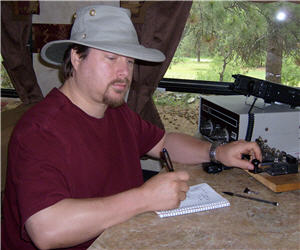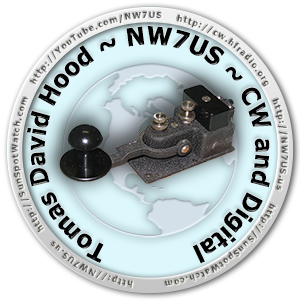 I'm Tomas David Hood. I am an amateur radio operator with the callsign of NW7US. I enjoy having two-way communications by way of shortwave radio signals, in the amateur radio hobby. The shortwave frequencies are those in the High Frequency (HF) radio spectrum. Amateur radio in the United States of America enjoys the allocation of many frequencies in a number of 'bands'; in the Mediumwave, HF, VHF, UHF, and higher radio spectrum.
I'm Tomas David Hood. I am an amateur radio operator with the callsign of NW7US. I enjoy having two-way communications by way of shortwave radio signals, in the amateur radio hobby. The shortwave frequencies are those in the High Frequency (HF) radio spectrum. Amateur radio in the United States of America enjoys the allocation of many frequencies in a number of 'bands'; in the Mediumwave, HF, VHF, UHF, and higher radio spectrum.
NW7US is the Amateur Radio call-sign issued by the Federal Communications Commission to my Ham Radio Station, conferring the right to operate this equipment under certain privileges. This call-sign is assigned to me as both an identification of my Amateur Radio station, as well as a reference to those privileges I have been granted after having passed both a series of written examinations which cover rules, procedures, technical theory, and related knowledge, and a series of Morse code proficiency tests.
It seems that I have always been interested in radio communications. In the early 1970s, I discovered the world of shortwave radio, when I explored a radio which was owned by my parents. This Sony four-band portable radio had a shortwave band. Tuning it, I discovered a number of International Shortwave Radio Broadcast stations, like Radio Australia, the BBC, Radio South Africa, Radio Canada International, and so many others. I also discovered the time station, WWV, on which I heard the hourly solar and geophysical report, talking about sunspots and other interesting indexes. This launched my love of both radio communications, and radio propagation along with the Sun-Earth connection.
 Morse code proficiency is no longer required as an element of the FCC test; you no longer need to learn and demonstrate knowledge of Morse code in order to obtain an FCC Amateur Radio license. However, Morse code is becoming very popular among Amateur Radio, again. This is for a variety of reasons, of course: those who are into preparing for the worst-case ('preppers') are learning Morse code because they know it is an effective means of communication when the main methods may no longer be available; DXers know that you can work a greater area of the world given all of the same parameters (antenna, transmitter power, propagation conditions); others simply love the idea of Morse code as a language.
Morse code proficiency is no longer required as an element of the FCC test; you no longer need to learn and demonstrate knowledge of Morse code in order to obtain an FCC Amateur Radio license. However, Morse code is becoming very popular among Amateur Radio, again. This is for a variety of reasons, of course: those who are into preparing for the worst-case ('preppers') are learning Morse code because they know it is an effective means of communication when the main methods may no longer be available; DXers know that you can work a greater area of the world given all of the same parameters (antenna, transmitter power, propagation conditions); others simply love the idea of Morse code as a language.
I was born back in 1965 (in Virginia) and I'm 47. I was first licensed in 1990, though I have been a real high-frequency fan since the early 1970s when I discovered Shortwave Radio. I loved hearing the foreign stations. Using HF is like traveling without leaving home. I love meeting new folks.
 In general, my station runs 100 watts out of an Icom IC-7000. I am using the KK7UQ home-built digital interface with the Ham Radio Delux + DRM software. My Morse code key is one of two: a WWII Navy Signaling Key (originally used by the Navy for ship-to-ship signal lamps), or a modified Vibroplex key that is now a 'paddle' key (moves side-to-side, requiring an electronic keyer). My antenna is a Hustler mobile vertical antenna so my situation is marginal. I operate mostly on 20 meters digital, often on JT65A weak-signal digital mode for HF using JT65-HF software, or Olivia digital modes.
In general, my station runs 100 watts out of an Icom IC-7000. I am using the KK7UQ home-built digital interface with the Ham Radio Delux + DRM software. My Morse code key is one of two: a WWII Navy Signaling Key (originally used by the Navy for ship-to-ship signal lamps), or a modified Vibroplex key that is now a 'paddle' key (moves side-to-side, requiring an electronic keyer). My antenna is a Hustler mobile vertical antenna so my situation is marginal. I operate mostly on 20 meters digital, often on JT65A weak-signal digital mode for HF using JT65-HF software, or Olivia digital modes.
I have some very specific areas of interest in my love of radio and space weather.
My all-purpose amateur radio website is HFRadio.org, while my main personal NW7US.us callsign website is here. My YouTube Channel is here, so please visit and subscribe to the channel where I post a lot of amazing solar flare and other space weather videos. On Facebook, my Amateur Page is here, while my personal page is here. My Space Weather Facebook page is here. I am also on Twitter. I am @NW7US and my space weather/propagation is @hfradiospacewx - please add those if you are interested in following my amateur radio and space weather tweets. Thank you for your interest.
These are some of the websites I've created regarding specific interests that I have: [ Morse Code and CW (carrier-wave mode) | Space Weather, Solar Cycle, Radio Propagation | Radio Circuit & Propagation Analysis w/ACE-HF | Shortwave Radio (SWL) |- Digital (non-voice) radio modes | AM (Amplitude Modulation) Amateur Radio Resources | Radio and Space Weather Forums ]
+ I am the Propagation Editor for "CQ Communications Magazine", "The Spectrum Monitor Magazine", and previously before their demise: "CQ VHF Magazine", and "Popular Communications Magazine". I also wrote about propagation and other radio-related topics in "Monitoring Times", before its demise.
+ I am the owner, system administrator, and content provider of http://hfradio.org/ , http://SunSpotWatch.com and http://NW7US.us
+ I am a contributor to various amateur radio books, blogs, news articles, Wikipedia, and so on.
+ I am most often found on the High-Frequency Amateur Bands in the CW or Digital Modes sub-bands (look for me on 20 mainly).
+ The NW7US Ham Shack is located in Grid Square EN10pu / ITU Region 7 / CQ Zone 4
















 I'm Tomas David Hood. I am an amateur radio operator with the callsign of NW7US. I enjoy having two-way communications by way of shortwave radio signals, in the
I'm Tomas David Hood. I am an amateur radio operator with the callsign of NW7US. I enjoy having two-way communications by way of shortwave radio signals, in the 
 In general, my station runs 100 watts out of an Icom IC-7000. I am using the KK7UQ home-built digital interface with the Ham Radio Delux + DRM software. My Morse code key is one of two: a WWII Navy Signaling Key (originally used by the Navy for ship-to-ship signal lamps), or a modified Vibroplex key that is now a 'paddle' key (moves side-to-side, requiring an electronic keyer). My antenna is a Hustler mobile vertical antenna so my situation is marginal. I operate mostly on 20 meters digital, often on
In general, my station runs 100 watts out of an Icom IC-7000. I am using the KK7UQ home-built digital interface with the Ham Radio Delux + DRM software. My Morse code key is one of two: a WWII Navy Signaling Key (originally used by the Navy for ship-to-ship signal lamps), or a modified Vibroplex key that is now a 'paddle' key (moves side-to-side, requiring an electronic keyer). My antenna is a Hustler mobile vertical antenna so my situation is marginal. I operate mostly on 20 meters digital, often on 
